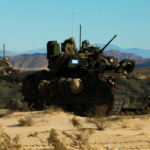
The Army recently awarded its first multi-year production contract for 155mm artillery shell production, with the service’s top acquisition official detailing a push to now produce more than 80,000 rounds per month by fiscal year 2025. Doug Bush, assistant secretary of the Army for acquisition, logistics and technology, told reporters on Monday the Army will soon boost artillery round production from 24,000 to 28,000 rounds per month while working “over the following year” to increase the capacity to build a…

 By
By 











